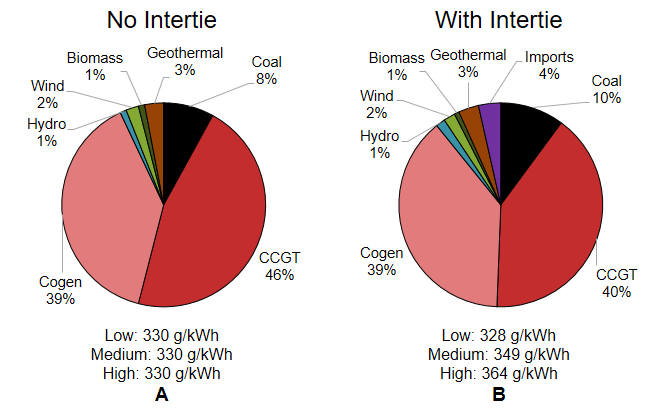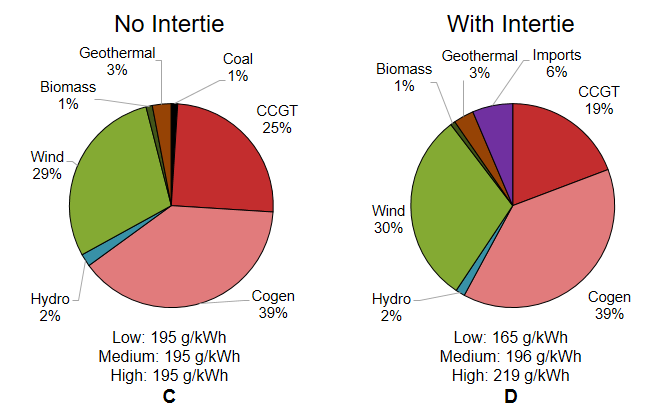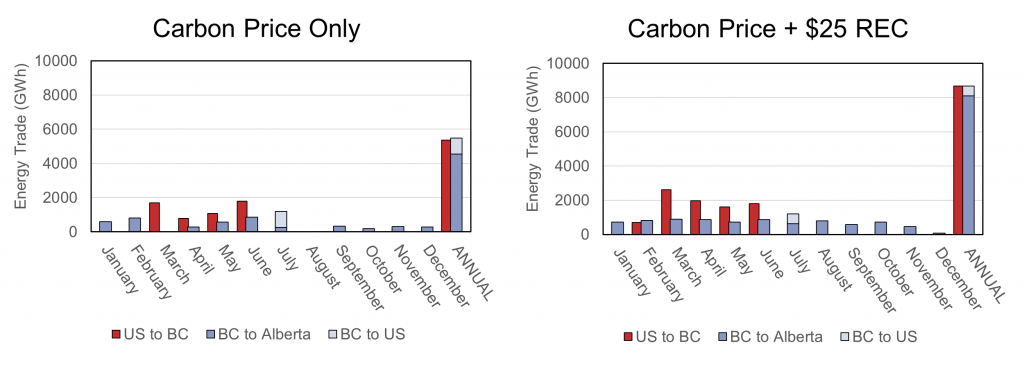Stronger electrical transmission systems can help lower electricity costs, improve reliability, and decrease greenhouse gas emissions. Recently it was suggested that BC could help Alberta meet its target of eliminating coal-fired generation from its electricity mix (currently 55% of production) by providing clean energy through an expanded transmission intertie. Presently, BC has an abundance of hydroelectricity while Alberta is dominated by fossil fuels.
Hydroelectric supplies in BC can help reduce Alberta’s carbon emissions in two ways: (1) by delivering clean energy to replace fossil fueled generation, and, (2) by providing flexible capacity needed to support additions of large amounts of variable renewables. As an example, surplus renewable energy from wind or solar in Alberta can be used in BC by storing water for future use. This stored water can then be utilized in Alberta at times when wind or solar are not producing. Currently, BC and Alberta share a single transmission connection (called an intertie) with a design capacity of 1200 MW. However, due to constraints of the Alberta electricity grid, this intertie is limited to a maximum of 780 MW. In 2015, the intertie carried 810 GWh of energy from BC to Alberta, corresponding to 1% of Alberta’s annual electricity demand, and 460 GWh of energy from Alberta to BC.
Alberta’s proposed carbon policies are analyzed in a previous post. Under these policies, carbon emissions from electricity generation are priced at $30/tCO2 for emissions exceeding the equivalent best-in-class gas-fired generator. This effectively increases the operating costs of coal-fired generation, with a comparatively lower impact on costs for combined cycle gas turbine (CCGT) and cogeneration facilities (Cogen). In addition, a Renewable Energy Credit (REC) of up to $35/MWh is proposed to supplement the income renewable energy generators receive from the market.
This post examines the combined BC-Alberta electricity system under Alberta’s proposed carbon policy using a long-term energy supply model. The model includes current and planned generating units in both provinces as well as a suite of potential options, such as natural gas-fired generation, wind and solar power, and imports from the US, for meeting future demand. One of these options is the expansion of the intertie between the provinces, the cost of which is based on recent large-scale transmission projects in the region. The model optimizes to find the lowest cost system for the combined region of BC and AB over the period from 2010 to 2060. This analysis only considers minimizing total cost of the system; it does not account for uncertainty in fuel prices or water levels.
Here we focus on the Alberta system in the year 2030 for two cases, one where AB is an isolated system (no intertie) and a second where the capacity of the current intertie may be increased if optimal (with intertie). The least cost supply mixtures in Alberta are examined for both the isolated (no-intertie) and the combined system (with intertie). Results are determined for the case where only the proposed CO2 price (carbon price only) is implemented, and, a case where the proposed CO2 price and a $25/MWh REC are implemented. It is assumed that internal transmission for both provinces is unconstrained.
Figure 1: Electricity supply in Alberta by type in 2030 with the carbon price only for (A) an isolated Alberta and (B) Alberta with an intertie and with the carbon price. Emissions intensities are given for Alberta electricity supply assuming low, medium, and high emissions from imports.
First, we consider the results for the case where there is a carbon price only, as shown in Figure 1. Optimal electricity supply mixes for Alberta in 2030 are shown with no intertie (A) and with the optimal intertie capacity (B). These two charts suggest that with the proposed carbon price, imports will be only a small portion of Alberta’s electricity mix. With the intertie, CCGT generation is reduced while coal generation and imports increase. Considering only variable costs (i.e., fuel, maintenance, and emissions), CCGT is less expensive than coal generation, meaning that, once installed, CCGT will run before coal. However, these variable cost savings are not enough to trigger new investment in CCGT. As a result, CCGT generation is only installed to the level required to meet peak demand increases and replace coal retirements. During off-peak hours this CCGT capacity displaces coal generation because of its lower variable cost.
In the scenario with the intertie (B), more of the load can be met by imports, reducing the need to install CCGT generation. The net result is that coal power, despite its higher variable cost and emissions, is used more with the intertie (B) than without (A). Figure 2: Electricity supply in Alberta by type in 2030 with the carbon price and a $25/MWh REC for (C) an isolated Alberta and (D) Alberta with an intertie. Emissions intensities are given for Alberta electricity supply assuming low, medium, and high emissions from imports.
Figure 2: Electricity supply in Alberta by type in 2030 with the carbon price and a $25/MWh REC for (C) an isolated Alberta and (D) Alberta with an intertie. Emissions intensities are given for Alberta electricity supply assuming low, medium, and high emissions from imports.
Figure 2 shows the 2030 Alberta electricity supply mix with both the carbon price and the REC for no intertie (C) and with optimal intertie capacity (D). With the carbon price and the REC, wind power is economically favorable and provides approximately 30% of the energy with or without the intertie. In these scenarios CCGT is installed to provide flexible capacity to balance wind production; however, with the intertie (D), imports are used to fill gaps in wind production during less windy months. This reduces the amount of CCGT required to meet demand during these periods.
Not shown in Figures 1 and 2 is the origin of the energy that is imported to AB. For the above cases, British Columbia does not generate extra energy for sale into Alberta. Instead, the power is purchased from the US market, generally at low-cost times, and sold into Alberta during high-cost times. This trade pattern is demonstrated in Figure 3 which shows the gross monthly and annual trade volumes between BC and Alberta, and between the BC and the US. The figure on the left is for the case with only a carbon price, and the figure on the right includes the carbon price and the REC.
Figure 3: Trade flows between the US, BC, and Alberta in 2030 under the proposed carbon price (left) and the carbon price with a $25/MWh REC (right).
As shown in Figure 3, on an annual basis, BC’s exports to Alberta are balanced by imports to BC from the US. US imports are concentrated during spring months, in off-peak hours, when hydroelectricity is plentiful and electricity prices in the Pacific Northwest are low. This power is then sold to Alberta over the course of the year to reduce the need for peaking generation during high demand months. When the REC is introduced, Alberta’s imports increase over the entire year as imported power is used to smooth variations in wind generation.
The emissions intensity of imported energy determines the net reduction or increase in emissions intensity of electricity in Alberta. Figures 1 and 2 give a high, medium, and low estimate of the emissions intensity of Alberta electricity assuming the imported electricity is generated by coal (900 g/kWh), the 2014 US average generation mix (525 g/kWh), or by renewable generation alone (0 g/kWh), respectively. In both cases with the intertie (B and D) emissions associated with electricity demand in Alberta decrease relative to the no intertie cases (A and C) only if imports are from low emissions sources (i.e. 0 g/kWh)
In both intertie scenarios, the model does not install any transmission capacity beyond the existing 1200 MW. This is because the cost savings enabled by the intertie are less than the cost of constructing the intertie itself. However, a large build-out of wind in Alberta as a result of carbon pricing and renewable energy credits will require additional flexibility to manage ramping, prevent over-generation, and provide backup power. It is possible that the additional value of these services would make intertie expansion desirable. An additional model with higher temporal resolution of the BC-Alberta system is being used to examine these potential benefits, the results of which will be in a future post.
In summary, the primary consequence of intertie capacity is the movement of energy from the US, through BC, to Alberta. In addition, the intertie provides access to flexible capacity which allows high wind penetration and reduces the need for flexible gas generation in Alberta. The potential emissions reduction from the intertie depends on the emissions from imported energy.
